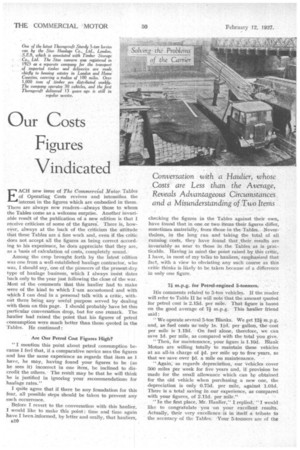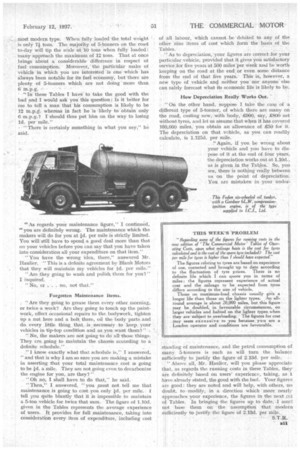Our Costs Figures Vindicated
Page 116

Page 117

If you've noticed an error in this article please click here to report it so we can fix it.
Conversation with a Haulier, whose Costs are Less than the Average, Reveals Advantageous Circumstances and a Misunderstanding of Two Items
EACH new issue of The Commercial Motor Tables of Operating Costs revives and intensifies the interest in the figures which are embodied in them. There are always new readers—always those to whom the Tables come as a welcome surprise. Another invariable result of the publication of a new edition is that I receive criticism of some of the figures. There is, however, always at the back of the criticism the attitude that these Tables are a fine work and, even if the critic does not accept all the figures as being correct according to his experience, he does appreciate that they are. as a basis of calculation of costs, completely sound.
Among the crop brought forth by the latest edition was one from a well-established haulage contractor, who was, I should say, one of the pioneers of the present-day type of haulage business, which I always insist dates back only to the year just following the close of the war. Most of the comments that this haulier had to make were of the kind to which I am accustomed and with which I can deal in a personal talk with a critic, without there being any useful purpose served by dealing with them on this page. I should probably have let this particular conversation drop, but for one remark. The haulier had raised the point that his figures of petrol consumption were much better than those quoted in the Tables. He continued : Are Our Petrol Cost Figures High?
" I mention this point about petrol consumption because I feel that, if a comparative novice sees the figures and has the same experience as regards that item as I have, he may, having found your figures to be (as he sees it) incorrect in one item, be inclined to discredit the others. The result may be that he will think he is justified in ignoring your recommendations for haulage rates."
I quite agree that if there be any foundation for this fear, all possible steps should be taken to prevent any such occurrence.
Before I revert to the conversation with this haulier, I would like to make this point : time and time again have I been.informed, by letter and orally, that hauliers, al0
checking the figures in the Tables against their own, have found that in one or two items their figures differ, sometimes materially, from those in the Tables. Nevertheless, in the long run and taking the total of all running costs, they have found that . their results are invariably as near to those in. the Tables as is .practicable. Having in mind the point raised by this critic, I have, in most of my talks to hauliers, emphasized that fact, with a view to obviating any such course as this critic thinks is likely to be• taken because of a difference in only one figure.
71 m.p.g. for Petrol-engined 5-tortners.
His comments related to 5-ton vehicles. If the reader will refer to Table II he will note that the amount quoted for petrol cost is 2.13d. per mile. That figure is based on the good average of 7/ m.p.g. This haulier friend said :
We operate several 5-ton Blanks. We get 124 m.p.g. and, as fuel costs us only is. lid. per gallon, the cost per mile is 1.13d. On fuel alone, therefore, we can save id. per mile, as compared with the total you give.
" Then, for maintenance, your figure is 1.10d. Blank Motors are willing totally to maintain these vehicles at an all-in charge of id. per mile up to five years, so that we save over id. a mile on maintenance.
" Again, as regards depreciation, our Vehicles cover 500 miles per week for five years and, if provision be made for the small allowance which can be obtained for the old vehicle when purchasing a new one, the depreciation is only 0.75d. per mile, against 1.01d. There is a total saving in our experience, as compared with your figures, of 2.11d. per mile."
" In the first place, Mr. Haulier," I replied, "I would like to congratulate you • on your excellent results. Actually, their very excellence.-is in itself a tribute to the accuracy of the Tables. Your 5-tonners are of the
most modern type. When• fully loaded the total weight is only 7-1 tons. The majority of 54onners on the road to-day will tip the scale at 10 tons When fully loaded : Many approach the maximum of 12 tons. That at once brings about a considerable difference in respect ot fuel consumption. Moreover, the particular make of vehicle in which you are intereSted is one which his always been notable for its fuel ecOnonry, but there are plenty of 5-tonners which are not doing more than 6 M.p.g.
In these Tables I have to take the good with the bad and I would ask you this question : Is it better for me to tell a man that his consumption is likely to be 12 m.p.g. whereas in fact he is likely to obtain only (3 m.p.g.? should thus put him on. the way to losing 1d. per mile."
• 'There is certainly something in what you say," he said.
" As regards your maintenance figure," I continued, " you are definitely wrong. The maintenance which the makers will do for you at id. per mile is strictly limited. You will still' have to spend a good deal more than that on your vehicles before you can say that you have taken into consideration all your expenditure on that item."
" You have the wrong idea, there," answered Mr. Haulier. "This is a definite agreement by Blank Motors that they will maintain my vehicles for id. per mile."
" Are they going to wash and polish them for you?" I inquired.
" No, at . . no, not that."
Forgotten Maintenance Items.
" Are they going to grease them every other, morning, or twice a week? Are they going to touch up the paintwork, effect occasional repairs to the, bodywork, tighten up a nut here and a bolt. there, oil the •body 'parts, and do, every little thing, that. Is; necessary to keep: your vehicles in tip-top condition and as you want them?"
"No, the makers are not going-to chi all-those things, They are going to maintain the chassis according to a definite schedule."
"I know exactly what that schedule is," I answered, "and that is why I am so sure you are making a mistake in asserting that your total maintenance cost is going to be id. a mile. They are not going even to decarbonize the engine for .you, are they?"
. " Oh no, I shall have to do that," he said. . "Then," I answered, "you must not tell me that maintenance is going to cost you only id. per mile. I tell you quite bluntly that it is impossible to .maintain a 5-ton vehicle fortwice that sum. The figure of 1.1.0d. given in the Tables represents the average experience of users. It provides for full maintenance, taking into consideration every item of expenditure, including cost of all labour, which cannot be debited to any of the other nine items of cost which form the basis of the Tables.
As to depreciation, your figures are correct for your particular ;vehicle, provided that it gives you satisfactory
service for five years at 500 miles per week and be worth keeping on the road at the end. or even some distance from the end of that five years. This is, however, a
new type of vehicle and neither you nor anyone" else can safely forecast what its economic life is likely to be.
How Depreciation Really Works Out.
"On the other hand, suppose I take the case of a different type of 5-tonner, of which there are many on the road, costing new, with body, £900, say, 800 net without tyres, and let us assume that when it has covered 160,000 miles, you obtain an allowance of 250 for it. The depreciation on that vehicle, as you can readily calculate, is 1.125d. per mile.
"Again, if you be wrong about your vehicle and you have to dispose of it at the end of four years, the depreciation works out at 1.10c1., as is given in the Tables., So, you see, there is nothing really between us on the point of depreciation. You are mistaken in your under standing of maintenance, and the petrol consumption of many 5-tonners is such as will turn the balance sufficiently to justify the. figure of 2.13d. per mile, •
"Above all, Mr. Haulier, will you please appreciate that, as regards the running costs in these Tables, they' are definitely based on users' experience, taking, as I. have already stated, the good with the bad. Your fignres are good : they are noted and will help, with others, no doubt, tomodify; in a direction which more nearly approaches your experience, the figures in the next of Tables. In bringing the figures up to date, I mue not base them on the 'assurnption that Modern sufficiently to justify the figure of 2.13d, per mile..




























































































































































